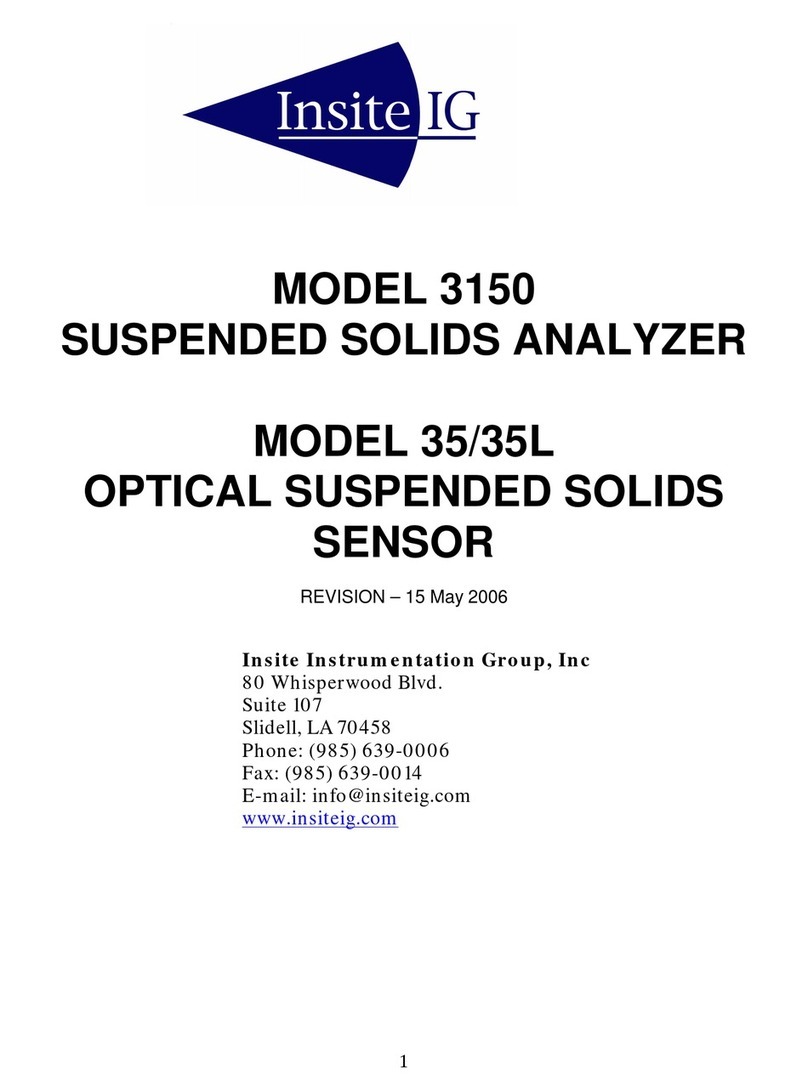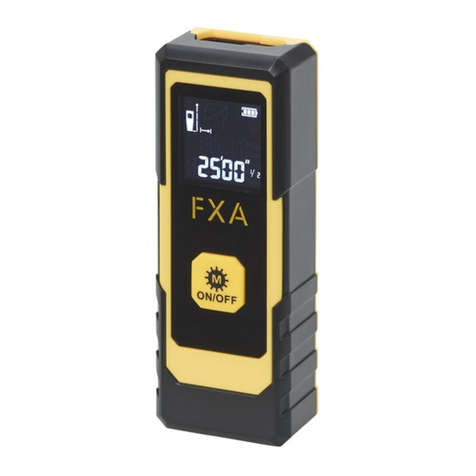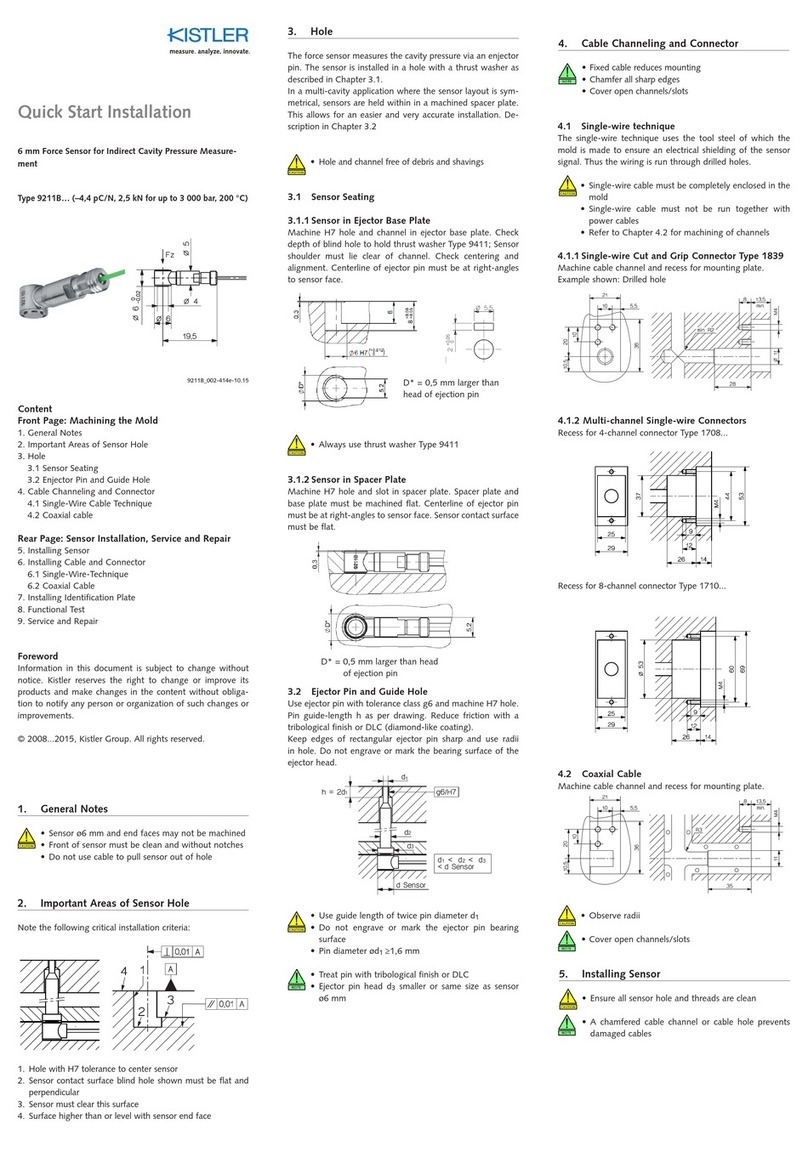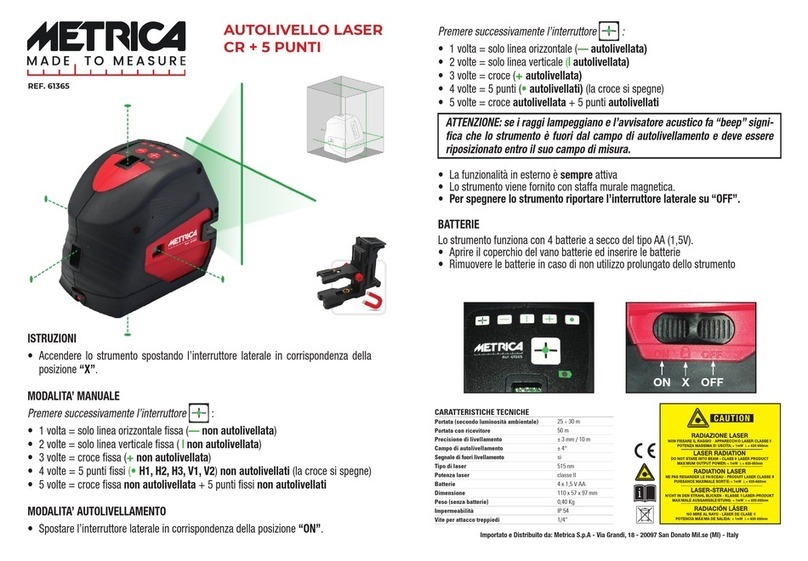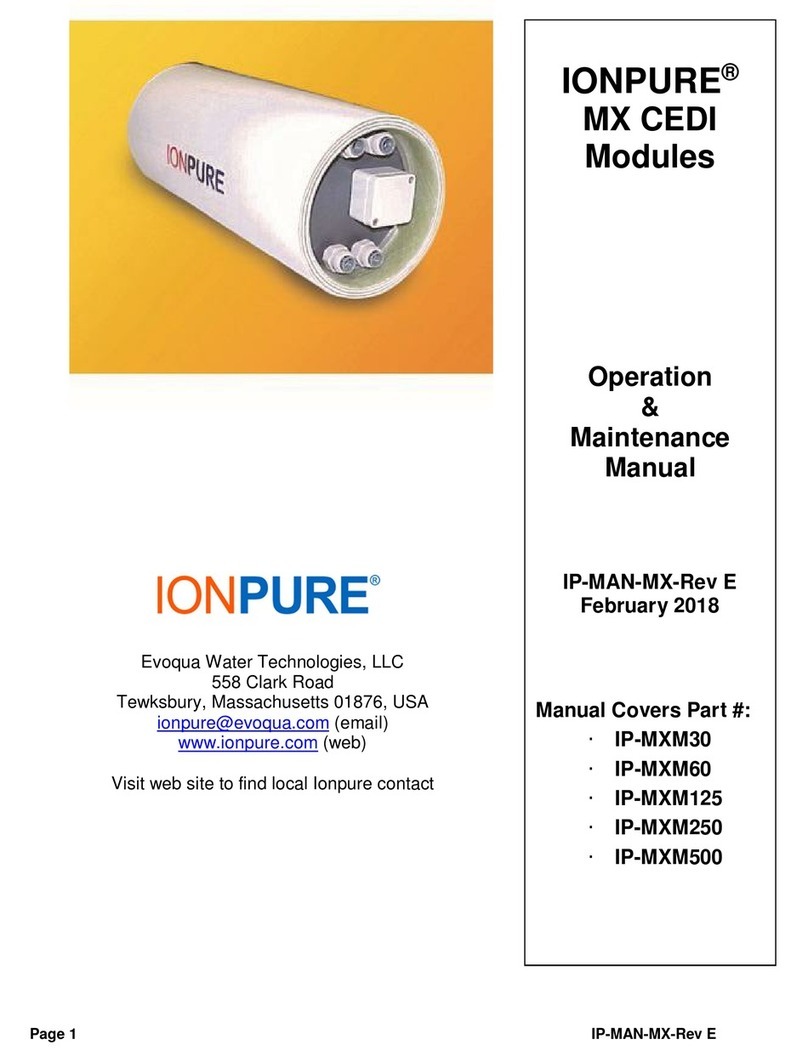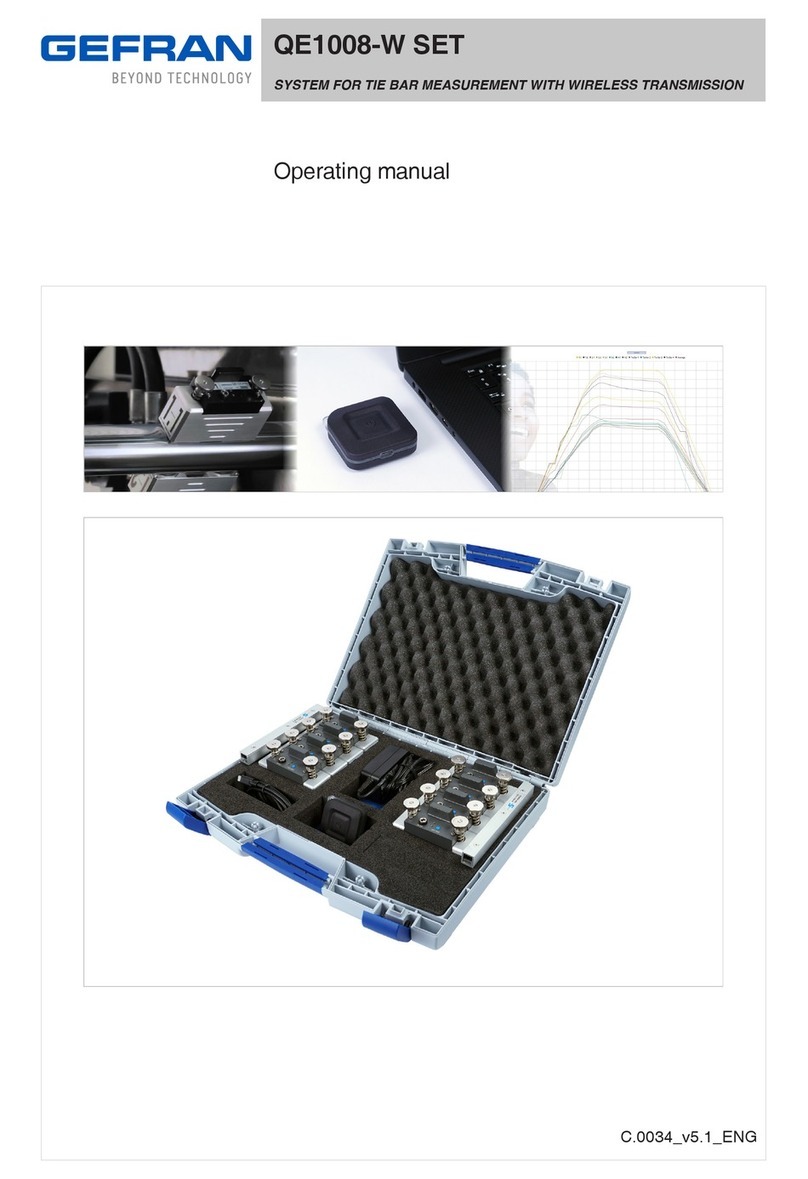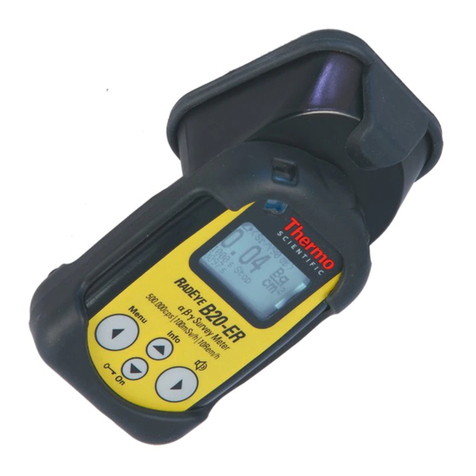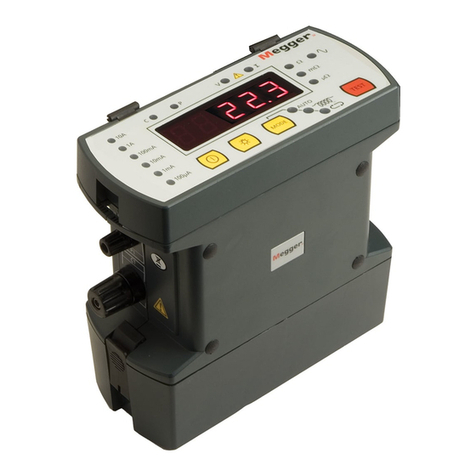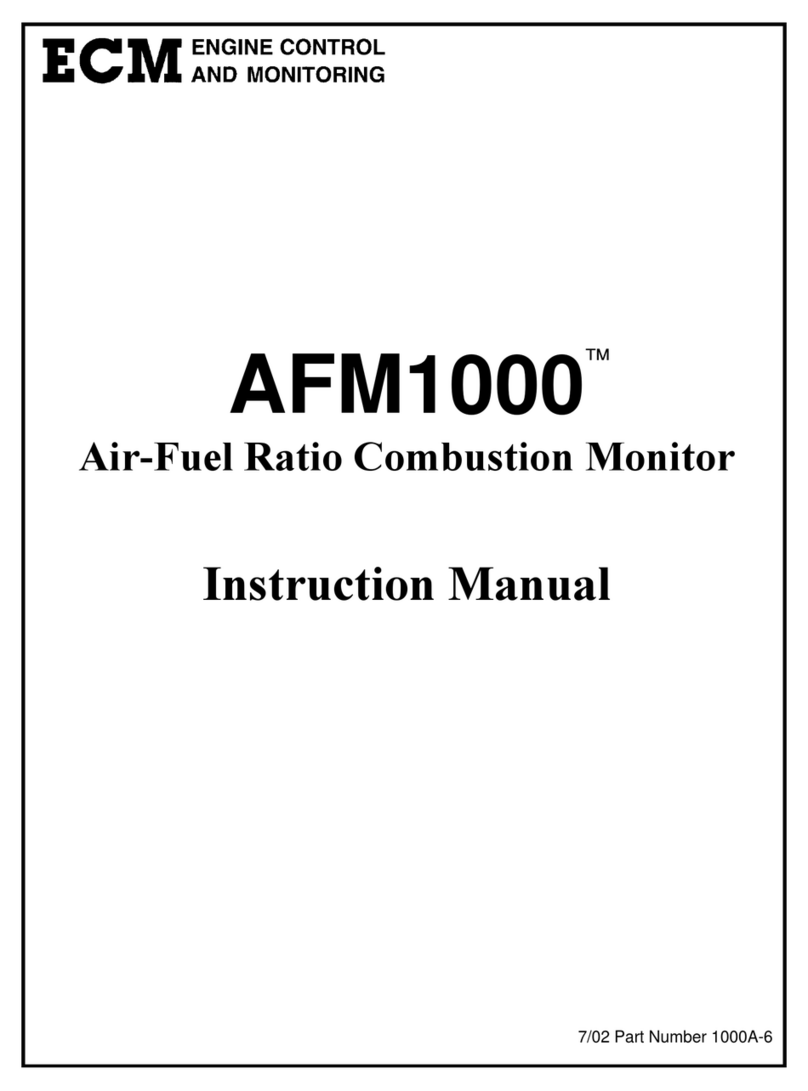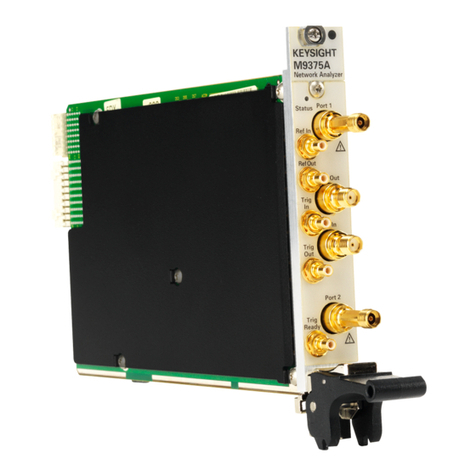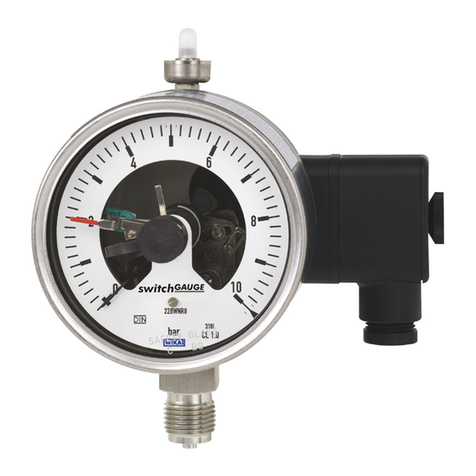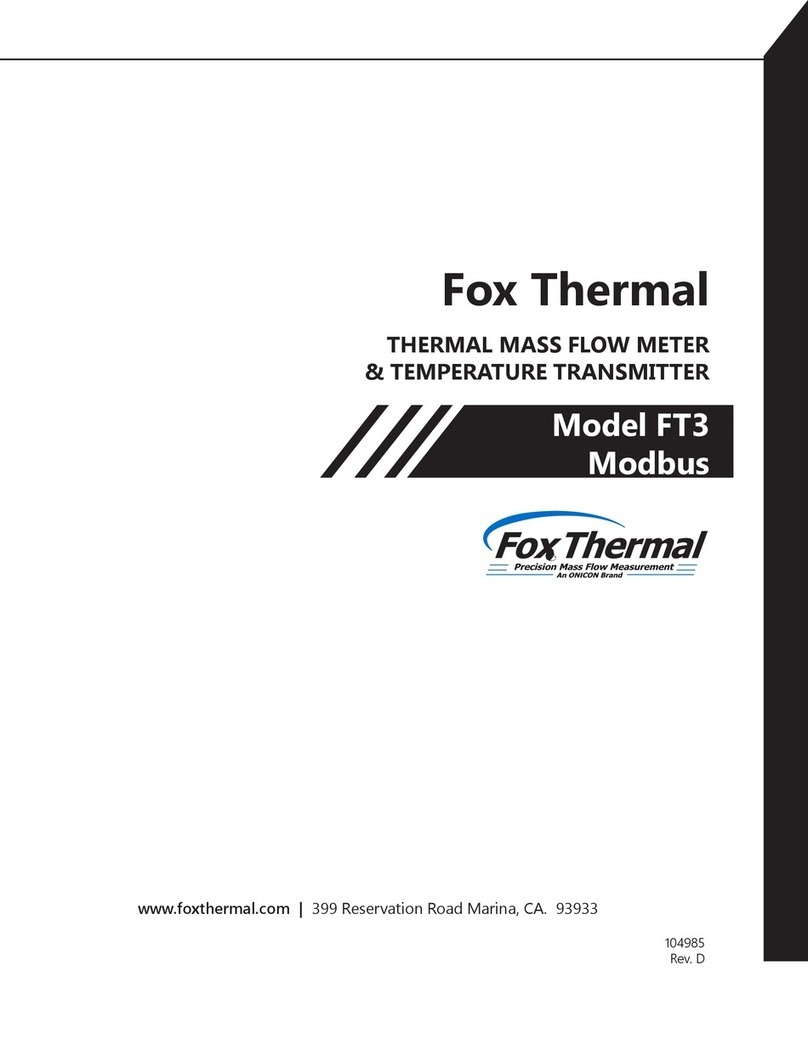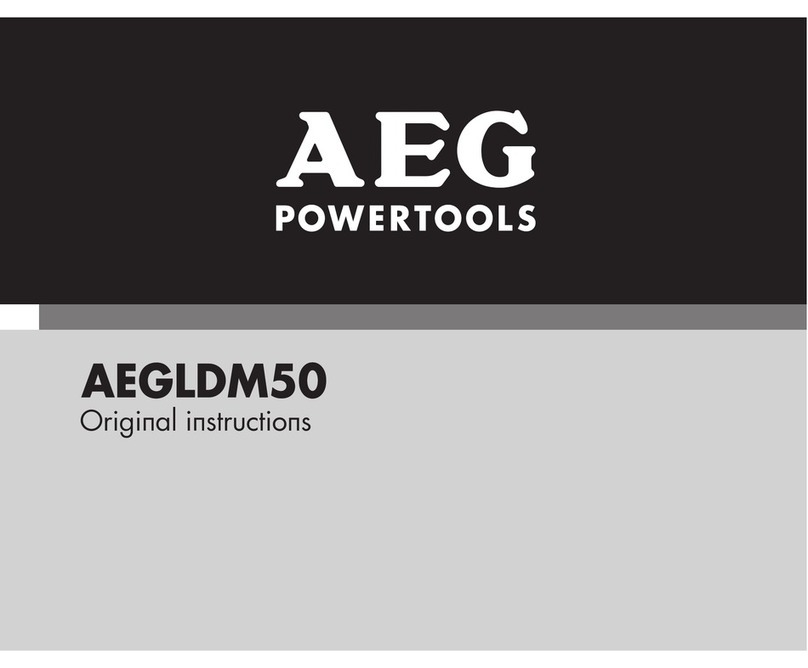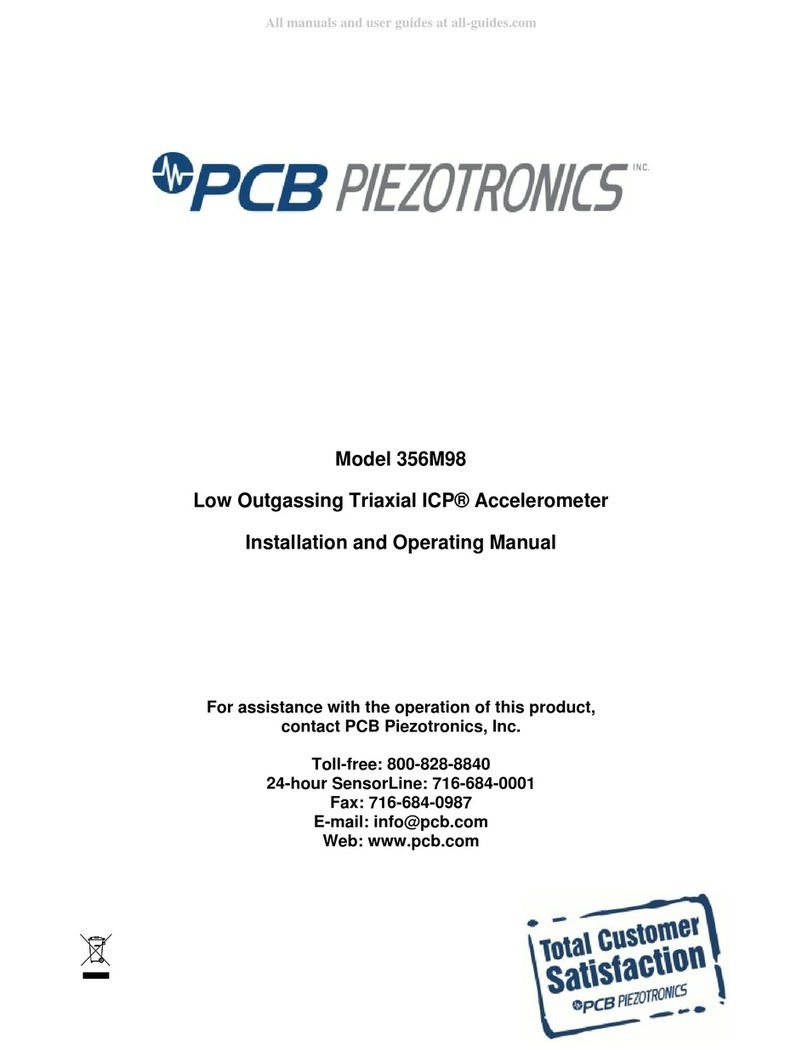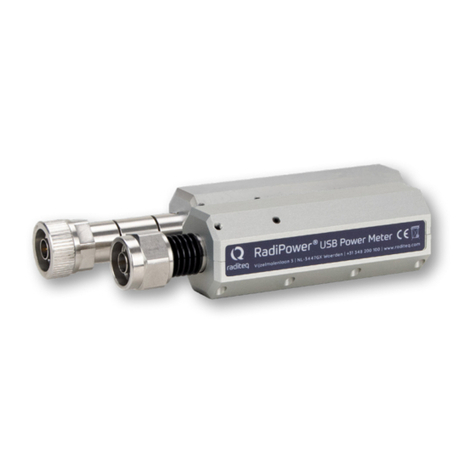InsiteIG MPA-48 User manual

1
MPA-48
MULTI-PARAMETER
ANALYZER
Feb. 8 , 2019
Insite Instrumentation Group, Inc
80 Whisperwood Blvd.
Suite 107
Slidell, LA 70458
Phone: ( 85) 63 -0006
Fax: ( 85) 63 -0014
E-mail: info@insiteig.com
www.insiteig.com

2
TABLE OF CONTENTS
GENERAL INFORMATION.................................................................................3
Product Description...........................................................................................3
Packaging ...........................................................................................................3
INSTALLATION...................................................................................................4
Analog Outputs..................................................................................................5
Digital Output .....................................................................................................5
Relay Outputs.....................................................................................................5
OPERATION .......................................................................................................6
RUN Mode...........................................................................................................6
MAIN MENU........................................................................................................6
SETUP Mode ......................................................................................................6
RELAYS ..............................................................................................................7
Clean Mode.........................................................................................................8
ANALOG OUTPUT .............................................................................................8
MODBUS.............................................................................................................9
CHANNEL ENABLE............................................................................................9
SENSOR SETUP...............................................................................................10
DO Sensor ........................................................................................................10
SS SENSOR......................................................................................................12
pH SENSOR......................................................................................................14
ORP SENSOR...................................................................................................15
TEST Mode .......................................................................................................16
ERROR MESSAGES ........................................................................................17
MAINTENANCE ................................................................................................18
GUARANTEE AND REPAIR POLICY ..............................................................20
Appendix A - Modbus Protocol ........................................................................1
Appendix B – Jet Clean System ......................................................................1

3
GENERAL INFORMATION
Product Description
The MPA-48 Multi-Parameter Analyzer comes standard with 4 channels for the continuous
measurement of dissolved oxygen, suspended solids, pH and/or ORP in an aqueous solution. It can be
easily upgraded to handle up to 8 channels with the addition of daughter boards and sensors. The
microprocessor-based electronics of the MPA-48 analyzer provide a high degree of flexibility and ease of
use. The instrument is designed to operate with any combination of InsiteIG sensors in a variety of
applications. The DO sensor to be used with this analyzer is an optical type sensor that measures the
fluorescence and quenching reactions of a ruthenium complex that is immobilized in a sol-gel matrix.
The SS sensor operates on the principle of single gap light absorption as a means of detecting the
presence of suspended solids. The pH and ORP sensors are flat glass electrodes.
The Model 10 Dissolved Oxygen sensor is designed for the continuous monitoring of dissolved
oxygen in water and wastewater where parts per million accuracy is required. The unit will display
dissolved oxygen content in PPM, mg/l or %SAT. The resolution in PPM and mg/l mode is 0.01 over a
range of 0.00 to 3.99 and 0.1 over a range of 4.0 to 25.0. The resolution in %SAT mode is 0.1%SAT
over a range of 0.0 to 99.9%SAT and 1%SAT over a range of 100 to 400%SAT. Temperature is
displayed in 0.1 degree Celsius increments over a 0.0 to 50.0 degree Celsius range or 1 degree
Fahrenheit increments over a 32 to 122 degree Fahrenheit range. It incorporates self-cleaning optics via
air or water jet.
The Model 15 TSS sensor has been designed for medium ranges (0 to 30,000 mg/l) as commonly
found in aeration basins of wastewater treatment plants and comes in pipe insertion configurations. The
Model 15L sensor has been designed for low ranges (0 to 1500 mg/l) as commonly found in effluent
streams. Both sensors utilize an infrared emitter to minimize color effects and compensates for emitter
variations due to temperature by measuring source brightness. They incorporate self-cleaning optics via
air or water jet.
The Model M50 is a microprocessor based preamp interface for the M51 and M52, pH and ORP
electrodes (please specify pH or ORP when ordering the M50). The unit will display the pH value in 0.01
pH resolution over a range of zero to 14.00 pH. However, the pH electrode is only rated for a pH range
of 2 to 12. The unit will display the ORP value in 1 mV resolution over a range of -2000 to 2000 mV.
Water temperature may also be measured for automatic temperature compensation. The temperature
may be displayed in degrees Celsius or degrees Fahrenheit. Temperature is displayed in 0.1 degree
Celsius increments over a 0.0 to 50.0 degree Celsius range or 1 degree Fahrenheit increments over a 32
to 122 degree Fahrenheit range. They incorporate self-cleaning via air or water jet.
Packaging
The analyzer is housed in a NEMA 4X enclosure (see Drawing IIG07N111 for Outline and Mounting)
and is designed for outdoor mounting. For areas where the environmental temperature is expected to
drop below 14 degrees Fahrenheit (-10 degrees Celsius) for extended periods of time, the optional
automatic heater assembly is recommended.

4
INSTALLATION
1. The MPA-48 analyzer should be located to allow convenient access for an operator to read and
technician to install and maintain. A rear rail mounting kit is available for the standard enclosure
(see Drawing IIG07N110). This mounting kit is design for a standard 2” handrail but can be
adapted to square or angle handrails as well.
DO NOT! Locate the analyzer where it is likely to be
damaged during unrelated or other periodic maintenance such
as pressure washing catwalks.
2. Mount the sensor in the desired location. InsiteIG can supply a sensor handrail mounting kit that
easily mounts to most handrails and slide locks the sensor into place with out the use of tools.
(See drawings IIG02N004, IIG02N005, IIG03N004 and IIG03N005). Again, this sensor mounting
kit is design for a standard 2” handrail but can be adapted to square or angle handrails as well.
DO NOT install a pH/ORP holder (Model 50) without a pH
cartridge (Model 51) or an ORP cartridge (Model 52) installed
and properly seated in the pH/ORP holder. Installing a pH/ORP
holder without a pH or an ORP cartridge will void the warranty.
WARNING! – Before opening analyzer
cover; switch off the analyzer line power at the circuit
breaker to avoid risk of shock. Line power is present
on terminals even when analyzer is switched off.
WARNING! – Circuit breaker meeting IEC-
947-3 must be on line supply, in close proximity to
equipment and shall be marked as the disconnecting
device for the equipment.
3. Open the enclosure of the Process Analyzer. Pass all connection cables through glands or ½”
conduit in the bottom of the enclosure (gland and conduit are not supplied). The sensor input
connections are made to terminal blocks TB1 through TB4 (labeled SENSOR 1 through 4) on the
standard unit (see drawing IIG07R111) and TB2 of the daughter boards for sensor 5 through 8.
The four wires are color coded and there is a cable shield. Connect the RED wire to the terminal
labeled “RED”. Connect the GREEN wire to the terminal labeled “GRN”. Connect the WHITE
wire to the terminal labeled “WHT”. Connect the BLACK wire to the terminal labeled “BLK”.
Connect the cable SHIELD to the terminal labeled “SHLD”. The analog outputs are available
on the terminal block labeled TB8 & TB9 and the relay outputs are available on the terminal
block labeled TB5.

5
4. Power Selector Switch: Check switch S2 on the circuit board to be sure that it is set for the type
of power being used (115 volts or 230 volts). Power connections should now be made to the
terminal block labeled TB6. Turn power "on" by using switch S1. Close and secure the
enclosure.
5. Switch the circuit breaker on and the unit will now power up.
6. Once the unit is turned on, the unit will initialize and then jump into the "RUN" mode and begin
displaying Channel 1 “CH 1” content on the upper left-hand portion of the display and Channel 2
through 4 content below it and Channel 5 through 8 in the right-hand column.
Note: The Model 10 D.O. sensor undergoes a thorough and
accurate test and calibration procedure before shipment
from the factory. Calibration of the D.O. reading at startup
is not necessary and is not recommended.
Analog Outputs
Four isolated 4-20 or 0-20 milliamp signals capable of driving 600 ohms are available from the
terminal block labeled “Current Outputs”. See drawing IIG07R111 for details. The #1 analog output is
labeled "I1 & C1” and the #2 analog output is labeled “I2 & C2” and so on. Each analog output may be
assigned to any sensor channel. The Analog Outputs for the add-on channels are locate on the
respective daughter boards and labeled as such.
Digital Output
A Modbus communications (RS-485) output is available from TB7 and is labeled “Modbus”. This is a
three wire signal with a transmit plus (labeled X+), a transmit minus (labeled X-), and a transmit ground
or common (labeled X COM). The Modbus interface uses 8 bits, no parity, 1 stop bit. See drawing
IIG07R111 for details. The RS-485 interface is electrically isolated from the measurement and
microprocessor circuitry of the MPA-48. The communications protocol for the Digital Output is fully
described in Appendix A.
Relay Outputs
There are four independent programmable set point control relays that may be assigned to any
sensor channel. These relays are Form-C with contacts rated 10/6 amps resistive load at 125/250 VAC.
Two Form-A relays with contacts rated 10/6 amps resistive load at 125/250 VAC are used for the jet
clean function. The connections for the relay outputs are available from TB5. See drawing IIG07R111
for connection details.

6
OPERATION
Note! – In “Normal Operation” the hinge
cover is to remain tightly screwed closed. Under no
circumstance is it necessary for the operator to open
the enclosure during normal operation.
RUN Mode
The RUN mode is the normal operating mode of the analyzer and is entered upon power-up. When
the Run mode is entered the analyzer will determine what types of sensors are attached to each channel.
The display is continuously updated with the current measurement values. Also, the analog output and
the relays are updated according to the current conditions and their programmed functions. In the event
of an error or alarm condition the display will indicate the problem in plain English text.
The supplied sensors have been calibrated at the factory. Sensor information for the Model 15/15L
TSS sensors are stored in non-volatile memory of the analyzer. If a Model 15/15L is connected to the
analyzer and the sensor information does not match the information stored in the analyzer, the analyzer
will display a configuration message. The configuration message for the Model 15/15L TSS sensor is
“**Zero sensor**”. These messages will appear whenever the sensor is changed.
While in the RUN Mode, the time to next scheduled clean cycle can be viewed by pressing and
holding either arrow key. A clean cycle can be demanded by pressing the ENTER key while in the RUN
Mode, see the section on Demand Clean.
MAIN MENU
The MAIN MENU is accessed by pressing the “MENU” key while in the RUN mode of operation.
There are three options available from the main menu. Use the arrow keys to switch between RUN,
SETUP, and TEST, and then press the "ENTER" key to select.
SETUP Mode
This mode of operation allows the user to customize the unit to the specific operation and needs of
the facility. There are a total of five subcategories that may be adjusted.
Operation of the SETUP MODE proceeds as follows:
From the MAIN MENU, select SETUP and the five menu options will be displayed. Use the
“ARROW” keys to move the cursor to the desired SETUP option, and then press the “ENTER” key. A
menu with five options will be displayed. The options are:
RELAYS
ANALOG OUTPUT
MODBUS
CHANNEL ENABLE
SENSOR

7
Pressing the “MENU” key will return to the previous page. To return to the RUN mode, press the
“MENU” key until the MAIN MENU is displayed and then press the “ENTER” key with the RUN mode
selected.
RELAYS
When the RELAYS option is selected from the SETUP menu, the operator is prompted to select
which relay is to be configured. There are five menu options for configuring the setpoint relays.
OP MODE - defines operation mode of relay as a high or low setpoint.
ON SETPOINT - defines when the relay will energize.
OFF SETPOINT - defines when the relay will de-energize.
FAIL MODE - defines the relay state during an alarm condition (no change, ON, or OFF).
CH ASSIGN - defines to which sensor the relay is assigned. A sensor may be assigned to more
than one relay.
There are four menu options for configuring the clean relays.
SYSTEM TYPE - defines what type of cleaning system is used.
CLEAN SCHEDULE - defines how often a cleaning cycle will occur.
CLEAN JET TIME - defines duration of time the clean relays will be energized.
CLEAN RECOVERY TIME - defines how long the reading holds after the clean cycle has ended.
Note: Do not attempt to adjust relay set points values until
a working sensor has been connected to the channel.
Otherwise, the analyzer may not display the correct units
(TSS or D.O.) for the channel.
Low Setpoint
If a relay “OP MODE” has been set as a LOW setpoint, then the corresponding relay will energize if
the reading falls below the value set in the “ON SETPOINT” parameter. Once the relay has been
energized by a low reading, it will not be de-energized until the reading rises above the value set in the
“OFF SETPOINT” parameter. The relay “OFF SETPOINT” value MUST be greater than or equal to the
“ON SETPOINT” value in this mode.
High Setpoint
If a relay “OP MODE” has been set as a HIGH setpoint, then the corresponding relay will energize if
the reading rises above the value set in the “ON SETPOINT” parameter. Once the relay has been
energized by a high reading, it will not be de-energized until the reading falls below the value set in the
“OFF SETPOINT” parameter. The relay “OFF SETPOINT” value MUST be less than or equal to the “ON
SETPOINT” value in this mode.

8
Clean Mode
The jet clean system is intended to be connected to relays “CLN 1” & “CLN 2”. The relays are
connected to an InsiteIG compressor, CA-2 and CA-4 or a customer supplied air or water source and a
shut-off valve. See drawing IIG07R113, IIG07R112, IIG07R114 and IIG07R116 for details. To program
the Clean Type go to Setup Menu – Relays – CLN Relays – System Type and select the appropriate
clean system; “CA2 Clean”, “CA4 Clean”, “House”. House clean is used for customer supplied air or
water.
The CLEAN SCHEDULE program parameter determines how often the jet clean cycle will occur.
This parameter can be set to values of 10 minutes to 24 hrs. Typically, a clean interval of 2 hrs works
well for aeration basins. In colder climates, condensation may form then freeze in the jet-clean tubing.
To prevent this, set the clean interval to 10 or 20 minutes. If this is set to “0” then cleaning is turned off.
The CLEAN JET TIME program parameter determines how long the jet clean cycle will last. The
CLEAN PULSE can be set to values of 5-seconds to 90-seconds with a 1-second resolution. Typically, a
clean pulse of 30-seconds works well for aeration basins. The analyzer will hold all the measurement
reading during the clean cycle and the recovery period which is equal to the programmed clean jet time.
In CA2 (2 channel clean system) Clean mode, a standard clean cycle will consist of the channel 1
sensor being cleaned for the programmed clean jet time immediately followed by the channel 2 sensor
being cleaned for the programmed clean jet time. For channels 3 & 4 a second CA-2 compressor can be
connected in series with the first.
In CA4 (4 channel clean system) Clean mode, the compressor is turned on for the whole duration of
the clean cycle and the MPA-48 sends a series of pulses to the compressor so each of the four sensors
will be cleaned sequentially.
In House Clean mode, both clean relays are turned on for the whole duration of the clean cycle.
The CLEAN RECOVERY parameter determines how long the analyzer will hold the DO reading after
the cleaning jet time has expired. The default setting is 1 minute which is adequate in most applications.
However, increased recovery time may be required for applications where the sensor is in stagnant
water or dead zones.
Demand Clean
When the analyzer is in the RUN mode pressing the "ENTER" button will cause a clean cycle to
begin (if the CLEAN SCHEDULE is not set to OFF). Performing demand clean doesn’t affect the normal
clean schedule.
ANALOG OUTPUT
When the ANALOG OUTPUT option is selected from the SETUP menu, the operator is prompted to
select which analog output is to be configured. There are five menu options for configuring the analog
outputs.
TYPE - selects either 4-20mA or 0-20mA operation for the analog output.
FULL SCALE - defines the value that will cause the analog output to go to 20mA.
MIN SCALE - defines the value that will cause the analog output to go to 0/4mA.
FAIL MODE - defines the value of the analog output during an alarm or error condition (no change,
full scale, or min scale).
CH ASSIGN - defines to which sensor the analog output is assigned. A sensor may be assigned to
more than one analog output.

9
MODBUS
There are three menu options for configuring the serial digital output.
Comm Address – defines the address of the analyzer
Comm Baud Rate – defines the baud rate of the digital output
Comm Mode - defines the communications mode as RTU or TCP
Appendix A describes the Modbus protocol implementation in the MPA-48.
CHANNEL ENABLE
When the CHANNEL ENABLE option is selected from the SETUP menu, the operator is prompted to
select which sensor channel is to be configured. The selected channel may be ENABLED or DISABLED
by pressing the “ARROW” keys and then pressing the “ENTER” key.

10
SENSOR SETUP
Each channel has its own sensor setup menu. The analyzer will select the appropriate menu for the
type of sensor that is currently connected to each channel.
DO Sensor
General
The Model 10 sensor has been designed to require very infrequent calibration. Unlike polaragraphic
systems, light fouling of the sensing element should not affect the accuracy of the reading, but should
only slow the response time of the system. (However, heavy biological fouling that prevents reasonable
sensor contact with the water will cause erroneous readings.) With the sensor kept reasonably clean, the
calibration should hold for 3 months to a year, depending upon conditions.
Note: The Model 10 D.O. sensor undergoes a thorough and
accurate test and calibration procedure before shipment
from the factory. Calibration of the D.O. reading at startup
is not necessary and is not recommended.
The MPA-48 analyzer allows the user to select from two different calibration procedures. The
procedure can be selected by choosing SETUP from the main menu. Once the SETUP menu appears,
use the arrow keys to choose the “SENSOR” option, and then select the desired sensor.
Sensor Calibration to a Reference
Calibration to a known reference is the easiest, simplest, and also the preferred method of calibration
when calibration is required. Calibration option number 1 “SENSOR REF CAL” allows the operator to
make adjustments to the D.O. reading to agree with any other source of D.O. information. THIS
CALIBRATION PROCEDURE MUST ONLY BE USED ON A CLEAN SENSOR. IF THE SENSOR IS
READING ERRONEOUSLY DUE TO HEAVY BIOLOGICAL FOULING, USE OF THIS CALIBRATION
METHOD WILL RESULT IN UNRELIABLE RESULTS. The sensor must be stable in the water to be
used as a reference before beginning this procedure. From the SENSOR SETUP menu, choose the
“Sensor Ref Cal” option, and press ENTER. The analyzer will now read the sensor for the period of time
indicated by the “dampening” parameter, and display the result as D.O. in PPM. If this result matches
the reference, simply press ENTER to exit. Otherwise, use the arrow keys to adjust the reading to match
the reference value, and then press ENTER to store this new value. This procedure is primarily an
adjustment to the offset value of the sensor, but an adjustment in slope will also be made when this
procedure is performed.
Sensor Slope Adjustment (NOT RECOMMENDED)
If performed correctly, the previously described “Sensor Calibration to a Reference” should be all
that is required by the user. “Sensor slope adjustment” should only be attempted upon recommendation
from the factory.
Sensor calibration option 2 “SENSOR SLOPE ADJ” allows the user to adjust the span of the sensor,
but this procedure must only be used immediately AFTER the sensor has been “zeroed” using calibration
option 1 with the sensor submerged in a zero oxygen solution. This zero solution may be prepared by
adding one tablespoon of sodium sulfite salt per liter of tap water in an open container (bucket). The
sodium sulfite salt will remove all oxygen from the water as it dissolves. Stir the water for about one
minute to dissolve the salt. Submerge the Model 10 sensor in this water and allow it to rest for at least
30 minutes. Make sure that no air bubbles are trapped on the face of the sensing element during the
soak. Once the sensor is stable, use the “Sensor Calibration to a Reference” procedure described

11
previously to set the D.O. reading to 0.03 PPM. THE CAL TO REFERENCE PROCEDURE IN ZERO
WATER MUST BE PERFORMED EVEN IF THE SENSOR READS ZERO FROM THE RUN MODE.
[NOTE: If the user’s application requires a zero that is absolutely accurate (frequent readings below 0.5
PPM), then the zero solution needed for this procedure should be mixed 12 to 24 hours before use, and
distilled water should be used in place of tap water. Freshly mixed solution actually has a value of about
0.04 PPM, but a calm solution at rest for 12 hours will drop down very close to absolute zero.]
Once a sensor has been properly zeroed, a slope adjustment may be made. Place the sensor in a
solution of known D.O. concentration, and allow about 15 minutes to fully stabilize. Choose the sensor
slope adjustment calibration procedure as option 2 “Sensor Slope Adj” from the SENSOR SETUP menu,
and press ENTER. Press ENTER again to bypass the “!Warning! Proper Zero Required” message. The
analyzer will now read the sensor for the period of time indicated by the “dampening” parameter, and
display the result as D.O. in PPM. If this result matches the reference, simply press ENTER to exit.
Otherwise, use the arrow keys to adjust the reading to match the reference value, and then press ENTER
to store this new value.
FACTORY DEFAULT
The Factory Default parameter allows the user to restore the sensor characteristic values of zero and
slope to the original factory settings.
TEMP. UNITS
The temperature units parameter allows the user to specify Celsius or Fahrenheit for the displayed
temperature units.
DAMPENING
The dampening parameter will allow the adjustment of the amount of averaging taking place. This is
entered in the amount of time it will take to achieve a stabilized reading, in seconds. This may be useful
when using the system in a new application or trouble shooting.
SALINITY
This option allows for the correction of salts in the water. The salinity correction range is 0 to 45 ppt
with a resolution of 1 ppt. Average sea water is about 34 ppt.
DISPLAY MODE
This option allows the dissolved oxygen to be displayed in either PPM or %SAT.
PASSCODE
The passcode parameter will allow the operator to limit access to the sensor setup parameters. The
passcode may be set to any three-digit number.

12
SS SENSOR
To do a complete calibration, three steps are required. The analyzer must first be zeroed, and then a
sample/snapshot is taken. After the sample has been analyzed, the span of the analyzer can be
adjusted to the sample. As long as the lenses are kept clean, frequent recalibration should not be
necessary. Every six months should be more than adequate for a complete calibration.
Any optically based device for measuring suspended solids should only be span calibrated against a
typical sample of the actual process water being measured. Synthetic laboratory standards will add
unnecessary inaccuracies to the system and are not recommended. The MPA-48 utilizes its
microprocessor memory in a unique way to make span calibration as easy and accurate as possible.
This calibration is performed as a two step process. First, the SNAPSHOT SAMPLE function of the
analyzer is used to store actual process conditions to the instrument's memory. Later, when standard
laboratory analysis results are available for those previous conditions, the analyzer's SPAN function will
recall the stored value and allow the user to adjust the span value accordingly.
The range of operation of the Model 15 sensors is 0-30,000 mg/l total suspended solids. Within this
range, accuracy and repeatability are only specified over a range of +/- 50% of the user's point of
calibration. Accuracy will be +/- 5% of the current reading or +/- 100 mg/l, whichever is greater.
Repeatability will be +/- 1% of the current reading or +/- 20 mg/l, whichever is greater.
The range of operation of the Model 15L sensor is 0-1500 mg/l total suspended solids. Within this
range, accuracy and repeatability are only specified over a range of +/- 50% of the user's point of
calibration. Accuracy will be +/- 5% of the current reading or +/- 2 mg/l, whichever is greater.
Repeatability will be +/- 1% of the current reading or +/- 2 mg/l, whichever is greater.
SENSOR ZERO
Submerge the sensor in clean water. It is important that the water used to zero the sensor be clean.
At the very least use potable water for this, and distilled water is even better. Do not use plant process
water of any type.
Select the "SENSOR ZERO" option from the SENSOR SETUP menu using the up and down arrow
buttons. Press the "ENTER" button. With the sensor submerged in clean water, wait about 15 minutes
and then press "ENTER". The analyzer will take about sixty seconds to zero. The display will return to
the SENSOR SETUP menu automatically when it is finished. Press the "MENU" button to exit or use the
up and down arrow buttons to select another sensor setup option.
SNAPSHOT
With the sensor submerged in the process to be measured and stable, select the "SNAPSHOT"
option from the SENSOR SETUP menu using the up and down arrow buttons. Press the "ENTER"
button. Pressing the "ENTER" button again will cause the analyzer to take a snapshot of the conditions.
The analyzer will take about sixty seconds to obtain a sample value. The display will return to the
SENSOR SETUP menu automatically when it is finished. At this point, the calibration of the analyzer
has NOT been altered at all; the conditions of the process water have only been stored in memory for
future use. Press the "MENU" button to exit or use the up and down arrow buttons to select another
sensor setup option.
At this time, take a physical sample of the process water from the same location so that it can be
analyzed using standard laboratory techniques to determine suspended solids concentration. This value
will be used during the span calibration.

13
SENSOR SPAN
This step is performed when an accurate laboratory value has been obtained from the sample
previously taken during the SNAPSHOT procedure. Select the "SENSOR SPAN" option from the
SENSOR SETUP menu using the up and down arrow buttons and press the "ENTER" button. The value
that was previously saved snapshot will be displayed. Use the up and down arrow buttons to adjust the
analyzer reading to the value of the laboratory analysis. Press the "ENTER" button when done. The
system is now calibrated and ready for normal operation. Press the "MENU" button to exit or use the up
and down arrow buttons to select another sensor setup option.
DEFAULT SPAN
This calibration mode will replace the current span calibration value with the factory default value.
This may be useful when using the system in a new application. If the analyzer has been properly
zeroed in clean water, the analyzer will read values that are typical for an average waste treatment plant.
No absolute accuracy is guaranteed after this procedure, but the numbers will, in the least, be useful for
observing trends in the suspended solids concentration over time.
RESPONSE TIME
The response time parameter will allow the adjustment of the amount of averaging taking place.
This is entered in the amount of time it will take to achieve a stabilized reading, in seconds. This may be
useful when using the system in a new application or trouble shooting.
SENSOR CURVE
The sensor curve mode will allow the selection of a standard TSS sensor curve which should be
used for most applications or a special TSS sensor curve which can be used for applications when the
standard curve does not apply. Contact the factory for details on using the special curve setting.
PASSCODE
The passcode parameter will allow the operator to limit access to the sensor setup parameters. The
passcode may be set to any three-digit number.

14
pH SENSOR
The pH/ORP sensors consist of two parts; the M50 Holder and the Electrode (M51 or M52). They
are shipped separately and must be assembled prior to installing the sensor into the process. The
pH/ORP electrodes must be properly seated in the pH/ORP holder to ensure reliable operation and
proper cleaning. This is achieved by first ensuring that there is silicone lubricant on the O-rings and seat
and then by screwing the electrode into the holder until the top of the electrode is even with the line
etched onto the jet clean boss. NOTE: Installing a pH/ORP holder without a pH or an ORP electrode
properly seated will void the warranty.
Calibration of pH electrodes have been greatly simplified, with ONE POINT or TWO POINT
calibration modes available.
pH buffers are special solutions which are used in the standardization or calibration of pH measuring
electrode systems. They are special because they have the ability to resist changing pH due to
contamination or dilution. The most common buffer dilutions are 4, 7 and 10 pH values. Other special
values can be purchased, and buffers for special biological and chemical applications are common.
pH buffers are supplied in either a powdered form to be mixed with distilled water or a premixed
liquid form. For pH buffers greater than 7, it is recommended that liquid buffer solutions be used
because they tend to be more accurate. However, liquid buffer solutions have a short shelf life (typically
3 months) which must be considered when ordering.
One Point Calibration Method
Select ONE POINT CAL from the setup menu. Submerge the sensor in the buffer solution. Press
the ENTER key. After the analyzer has acquired data, the pH value will be displayed. Use the UP and
DOWN arrow keys to change to the correct pH value and then press the ENTER key. The calibration is
stored in the non-volatile memory of the analyzer.
NOTE: This method of calibration only adjusts for asymmetry
in the electrode and thus should only be used in applications
where the process has a small range of pH values.
Two Point Calibration Method
Select TWO POINT CAL from the setup menu. Submerge the sensor in the first buffer solution.
Press the ENTER key. After the analyzer has acquired data, the pH value will be displayed. Use the UP
and DOWN arrow keys to change to the correct pH value and then press the ENTER key. Submerge the
sensor in the second buffer solution. Press the ENTER key. After the analyzer has acquired data, the
pH value will be displayed. Use the UP and DOWN arrow keys to change to the correct pH value and
then press the ENTER key. The calibration is stored in the non-volatile memory of the analyzer.
FACTORY DEFAULT
The Factory Default parameter allows the user to restore the sensor characteristic values of zero and
slope to the original factory settings.
TEMP. UNITS
The temperature units parameter allows the user to specify Celsius or Fahrenheit for the displayed
temperature units.
PASSCODE
The passcode parameter will allow the operator to limit access to the sensor setup parameters. The

15
passcode may be set to any three-digit number.
ORP SENSOR
The pH/ORP sensors consist of two parts; the M50 Holder and the Electrode (M51 or M52). They
are shipped separately and must be assembled prior to installing the sensor into the process. The
pH/ORP electrodes must be properly seated in the pH/ORP holder to ensure reliable operation and
proper cleaning. This is achieved by first ensuring that there is silicone lubricant on the O-rings and seat
and then by screwing the electrode into the holder until the top of the electrode is even with the line
etched onto the jet clean boss. NOTE: Installing a pH/ORP holder without a pH or an ORP electrode
properly seated will void the warranty.
SENSOR TYPE
Displays are normally in the American convention which produces a negative voltage during a
reduction of the platinum and a positive reading during the oxidation of the platinum. The European
convention reverses the polarities.
ORP OFFSET
Calibration of an ORP electrode is normally accomplished by equating millivolt levels to
concentration. This may be accomplished by noting the reading of the ORP electrode and relating the
reading to a laboratory analysis. Calibration standards may be generated by dissolving quinhydrone to
saturation in a pH 4 Buffer at 25 degrees Celsius, which should produce a millivolt reading of
approximately 250. By utilizing a pH 7 Buffer solution with quinhydrone, the generation should be
approximately 90 millivolts.
Select ORP OFFSET from the setup menu. Submerge the sensor in the buffer solution. Press the
ENTER key. After the analyzer has acquired data, the ORP value will be displayed. Use the UP and
DOWN arrow keys to change to the correct ORP value and then press the ENTER key. The calibration
is stored in the non-volatile memory of the analyzer.
PASSCODE
The passcode parameter will allow the operator to limit access to the sensor setup parameters. The
passcode may be set to any three-digit number.

16
TEST Mode
This mode of operation allows the user to perform basic test functions to aid in troubleshooting.
Operation of the TEST MODE proceeds as follows. From the Main Menu use the arrow keys to move
the cursor to the TEST option, then press the “ENTER” key. Use the arrow keys to select one of the
seven options, and then press the “ENTER” key.
VIEW SENSOR DATA
This option is intended primarily to aid the InsiteIG technical support engineers in troubleshooting.
The following sensor data is displayed: sensor type, sensor serial number, sensor reporting mode, and
sensor raw data. Press the “MENU” key to exit.
VIEW SENSOR CLK
This option will display the power line frequency which is used to filter the sensor data. Press the
“MENU” key to exit.
CAL ANALOG OUTPUT
This option will cause the analyzer to generate full scale output of 20mA on the selected analog
output. Use the “UP” and “DOWN” arrows keys to adjust the output, then press the “ENTER” key to
save.
TEST RELAYS
This option will test the setpoint and cleaning relays.
Setpoint relays:
This option will display the current status of the selected relay. To toggle the state of the relay,
press the "ENTER" key. The new status of the relay will be displayed. To exit, press the
"MENU" key.
Clean relays:
This option will display the current status of the clean relays. To toggle the state of the CLN1
relay, press the “UP” key. To toggle the state of the CLN2 relay, press the “DOWN” key. The
new status of the clean relays will be displayed. To exit, press the “MENU” key.
TEST MODBUS
This option will test the RS-485 communication port.
SOFTWARE VERSION
This option will display the current version of software in the analyzer. To exit, press the "MENU"
key.
VIEW SENSOR CHAR
This option is intended primarily to aid the InsiteIG technical support engineers in troubleshooting.
The characteristics for the selected sensor are displayed.

17
ERROR MESSAGES
During operation, the MPA-48 analyzer may determine that an error condition exists. If this happens,
the display will contain an error message. The 4 possible error messages are as follows:
**SENSOR NOT RESPONDING**
This error message indicates that the analyzer is not receiving any data from the sensor. This could
be caused by either the sensor is not properly connected to the analyzer or a faulty sensor or analyzer
electronics.
*SENSOR ERROR* (Model 10 only)
This error message will be displayed if the sensor’s electronics become faulty. Call the factory for
assistance.
**Zero Sensor** (Model 15/15L only)
The analyzer is indicating that a zero cal operation is required for proper operation. This can occur if
a new or different sensor has been connected to the analyzer. This would be indicated if the current
counts are greater than 5% of the pervious stored zero value.
*Ambient Error* (Model 15/15L only)
This error message will be displayed if the sensor is exposed to too much ambient light (exposed to
direct sunlight) or the sensor LED is faulty. Call the factory for assistance.

18
MAINTENANCE
The analyzer does not require any periodic maintenance. However, it may be necessary to
periodically clean the exterior of the analyzer. This may be done with a soft brush, broom or low
pressure water rinse.
DO NOT! use hi-pressure water or a pressure washer to clean
the analyzer. It is likely to be damaged during pressure washing.
The sensor must be kept clean for accurate readings. Normally, the jet clean system will adequately
perform this function.
Model 10 D.O. Sensor: In normal wastewater aeration basins the Model 10 Sensor will not require
a jet clean system; however it is important that the aqueous sample to be measured be allowed to come
in contact with the measuring surface. The sensor should be visually inspected on a monthly basis to
insure that rags and hair have not completely covered the measuring surface. During this time we
recommend rinsing the sensor with a water hose.
In systems with high bio-slim and scaling, the integrated jet clean system is recommended to prevent
the slim and scale from attaching itself to the measuring surface. If wiping the sensing element is
required, use a wet cloth, do not use a brush.
Fouling conditions at wastewater treatment facilities vary considerably from plant to plant.
Experience gained during the first few months of sensor operation will allow the plant operators to
determine their own reasonable schedule of sensor inspection. In no case should this inspection interval
exceed one year.
Model 15/15L TSS Sensor: The sensor must be kept clean for accurate readings. Normally, the jet
clean system will adequately perform this function. However, the sensor should be retrieved and
cleaned manually on a periodic basis to remove the heaviest fouling that may impair the performance of
the sensor. The frequency of this cleaning will vary depending on the application.
Model 51/52 pH/ORP Sensor: The electrodes are shipped with a protective boot over the pH glass.
This boot should be used to keep the electrode glass wet while the electrode out of service. If the
electrode system has been unused for a long period of time, immerse the flat glass end of the
electrode(s) in tap water for at least 30 minutes. This hydrates the pH flat glass and prepares the liquid
junction of the reference electrode for contact with the test solution. To maintain response, the electrode
system should always remain wet. The preferred storage solution is pH 4.0 buffer with saturated KCl
added. Tap water will suffice for short term storage.
NOTE: Do not soak in distilled water. Utilize the pliable
storage boot provided with the electrode(s) for storage.
Electrodes which are not broken or cracked can be restored, or rejuvenated, to full response by the
following procedures:
•Inorganic Scale Deposits -Dissolve the deposit by immersing the electrode first in 0.1M
HCl, then in 0.1M NaOH, and again in 0.1M HCl. Each immersion should be for a 5 minute
period.
•Organic Oil or Grease Films - Wash electrode tip in a liquid detergent and water. If film is
known to be soluble in a particular organic solvent, wash with this solvent. Rinse electrode
tip in tap water.

19
If these procedures fail to rejuvenate the electrode, the problem is probably a clogged reference
junction in the reference electrode portion of the electrode system. Cleaning the reference junction
involves heating a diluted KCl solution to 60 - 80 degrees Celsius. Place the electrode tip in the heated
KCl solution for approximately ten minutes. Allow the electrode to cool naturally before re-testing. If
these steps fail to improve the electrode response, replace the electrode.
Successful long term storage of an InsiteIG electrode depends entirely upon the care taken to assure
that the glass and reference junction remain immersed in the recommended storage solution. Electrodes
in storage with the protective rubber boot should be checked at least every 2 months to be sure that
there is an adequate amount of storage liquid. Electrodes stored in this manner will normally last for 2
years. If a stored electrode is allowed to dry the reference junction may become clogged with dried
electrolyte. Should this occur, attempt to rejuvenate the reference junction using the "Cleaning
Electrodes" procedure for reference junctions discussed earlier.

20
GUARANTEE AND REPAIR POLICY
MPA-48 Process Analyzer, Model 15/15L sensors, Model M50 electrode holder and related items are
guaranteed for two years against defective materials and workmanship. The Model 10 Dissolved
Oxygen Sensor is guaranteed for five years against manufacturing defects. They will be replaced or
repaired free of charge during the guarantee period. Call the factory at 985-639-0006 for a return
authorization number for traceability. Mark the package to the attention of the R/A number and address
it to the factory at 80 Whisperwood Blvd., Suite 107, Slidell, LA 70458. Freight to the factory is to be
paid by the customer and items should be insured in case of damage or loss of shipment.
All shipments are insured. If you receive a damaged unit, please notify InsiteIG Instrument
immediately at 985-639-0006.
Repairs to the equipment not covered by the guarantee will be billed per standard service charges.
Table of contents
Other InsiteIG Measuring Instrument manuals
